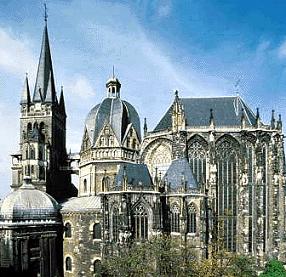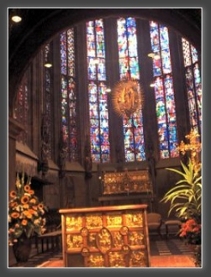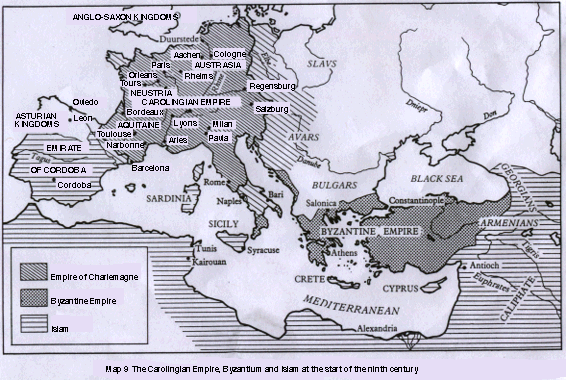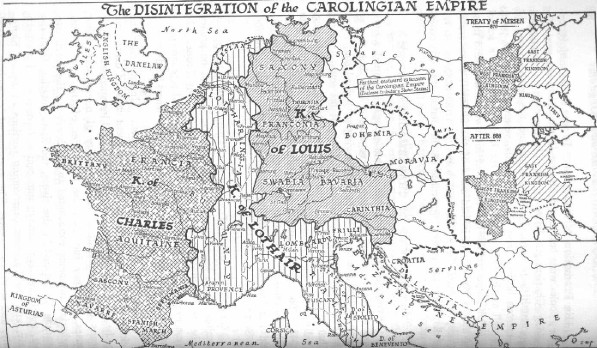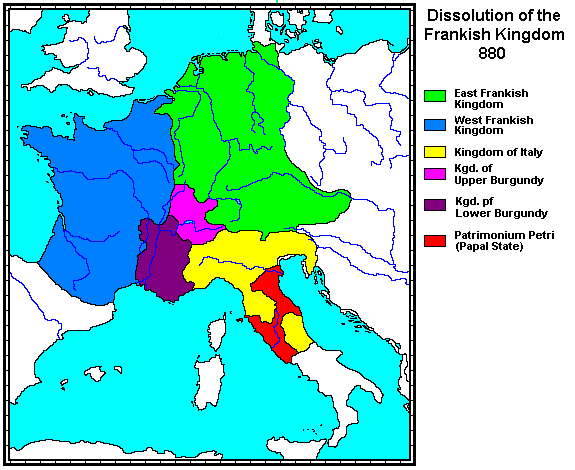The Carolingian Dynasty (751-987) and Its Impact on Later Medieval Politics
Key Events
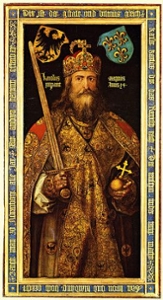
687: Pepin of Heristal absorbs Neustria at Battle of Tertry; Caroligian power established in Burgandy.
732: Charles Martel, son of Pepin, defeats Arabs at Poitiers --ends Muslim drive into Spain.
716-754: Boniface evangelizes the Germanic peoples with Carolingian support.
742: Boniface begins series of synods to reform Frankish church.
751: Pepin III "the Short" becomes King of the Franks.
755: Franks drive Lombards out of central Italy: creation of Papal States.
768-814: Charlemagne rules as King of the Franks.
774: Charlemagne defeats Lombards in northern Italy.
778: Charlemagne establishes Spanish March (Barcelona) as southern frontier against Muslim Spain.
782: Execution of 4500 Saxons to force submission in Saxony.
782: Alcuin of York begins reform of the Palace School.
787: Charlemagne conquers Bavaria and establishes the East March (Austria) as an eastern frontier against the Avars.
787: Charlemagne issues "The Charter of Modern Thought" advocating the education of the clergy and the reformation of monastic schools.
794: Capital established at Aachen ("New Rome").
796: Synod of Frankfurt -- Charlemagne condemns Seventh Ecumenical Council's position on icons.
ca. 750-800: Donation of Constantine forged, perhaps as a protest against Frankish domination of the Church.
Dec 25,800: Pope Leo III crowns Charlemagne "Emperor of the Romans."
814-840: Louis the Pious succeeds Charlemagne as "emperor."
842: Oaths of Strasbourg, Charles the Bald and Louis the German agree to ally against Lothar, eldest son of Louis the Pious.
843: Treaty of Verdun partitions the Carolingian Empire into three parts for each son.
870: Treaty of Mersen further divides Carolingian Empire, after Lothar's death, absorbing the middle kingdom.
875-950: New invasions of Vikings, Muslims, and Magyars further fragment the remaining kingdoms.
962: Ottonian dynasty succeeds Carolingian in Eastern Frankish Kingdom (Germany).
987: Capetian dynasty succeeds Carolingian in Western Frankish Kingdom (France).
Key Intellectual Figures
Follow the links for additional information on each:
- Einhard, Life of Charlemagne -- Important advisor to Charlemagne, he supervised the building of the cathedral at Aachen, as well as various palaces. He was also a diplomat for the court on occasion. His most important work is his biography of Charlemagne.
- Paul the Deacon -- He is best remembered for his histories of the Roman Empire and the Frankish kings, as well as a commentary on the Rule of Benedict of Nursia.
- Theodulf --Bishop of Orleans, theologian and poet. He encouraged education in the period and participated in the filioque controversy regarding the Nicene Creed.
- Alcuin of York -- The central figure of the Carolingian Renaissance, Alcuin was the rector of the Palace School, and was a key figure in bringing the learning of Celtic monasticism to the Continent. His numerous works include biblical commentaries, textual criticism, theological polemics, and legal commentaries. He is also significant for gathering the palace library in a time when books were few.
- John Scotus Erigena, On the Divisions of Nature -- He served in the court of Charles the Bald and represents the second generation of scholarship associated with the Renaissance. He is chiefly remembered for his mystical theology.
- Walafrid Strabo --A monk, Walafrid was a poet and historian and was associated with the court of Louis the Pious.
- Raban Maur --Another monastic scholar and teacher, his numerous books included biblical commentaries, works of theology, and The Universe, a medieval compendium-style encyclopedia, purporting to gather together all that was known in the period.
Questions
-
Do you find this argument convincing? Why or why not?
-
Has Aquinas sufficiently answered Anselm?
-
What would be the chief value of such an argument?
